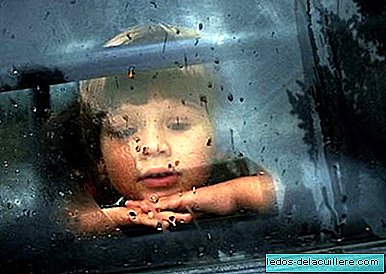
Today, in Babies and more, we offer you the first part of the interview we have done to the anthropologist María José Garrido with whom we will talk in depth about what their discipline can bring to the upbringing, interested in the different ways in which each culture attends and educates their children.
María José Garrido is a mother, historian, archaeologist and anthropologist. She has been investigating the relationship between parenting and culture for years, as well as the consequences of the different models of education and child care in adult life and in the type of societies they make up. He recently completed his doctoral thesis on anthropology of parenting, ethnopediatrics and respectful parenting on the Internet.
I would like, María José, to deepen the issue of violence. Is violence innate?
Not at all. There is no tendency in our biology towards violent behavior. In fact, the study of different species has shown that the status within the group is acquired, above all, by the attitude of cooperation and by the development of certain social functions that benefit the group. War, therefore, is a product of culture and not of biology. There is nothing in our genetics or in our neurophysiology that incites us to aggressiveness. Twenty international scientists from different disciplines came to these conclusions in 1986, by signing the Declaration on Violence, which refuted the supposedly scientific theories that justified violence and war. Violence, therefore, is learned.
Are there or have there ever been cultures that we can describe as nonviolent?
Among others, the French anthropologist Pierre Clastres has analyzed the “archeology of violence”, reviewing the theories about aggressiveness in primitive societies. He also came to the conclusion that war is a cultural construction. Throughout the history of mankind there have been and still exist peaceful cultures. Anthropological, neurobiological, psychological and psychiatric research agree that the natural tendency of our species, given our social nature, is integration and solidarity.
What common features did these peaceful cultures have?
Their relationships are based on cooperation and negotiation rather than confrontation. There is no competitiveness among adults or aggressiveness.
Can you tell us about some examples?
For example, the Yecuana and the Sanema, investigated by Jean Liedloff in Venezuela, do not know the unhappiness, the conflicts, the concept of work or the norms of our culture. In these societies, difference and diversity are accepted, so they are not intended to force or convince others. Life revolves around integration and reciprocity. They have an egalitarian character and their social system is usually based on kinship and friendship. The group and community concept prevails over the individual, so they lack the concept of intimacy or privacy. They share resources through reciprocity, which avoids any kind of social or economic inequality.
Was his way of raising and educating children especially loving?
In the light of research on groups living in conditions similar to the Stone Age, such as the Yecuana of Venezuela, the Bushmen of the Kalahari, the ache of Paraguay or the Arapesh of the Trobriand Islands, since the birth of the children they have been in contact physical with the body of someone, adult or child. In addition, babies and children remain close to all the events of the group. Children are not allowed to cry and breastfeeding occurs on demand for several years. Adults also usually sleep with children.
Among the kung san of the Kalahari, for example, they do not leave only the baby, they carry it in a kind of sling that allows them some mobility and breastfeeding at will. It is estimated that, on average, they breastfeed every 13 minutes. Babies do not usually cry and, when it occurs, they are comforted immediately with the chest. Weaning occurs when the next child will be born. It is common for the baby to be loaded in an upright position, such as between the ache, so that he can develop his motor capacity. In many of these cultures they conceive full-time motherhood, sleep the first year with the baby to protect it and remain in physical contact with the mother almost all day.
How were the upbringing in peaceful cultures?
In these groups the upbringing was loving, although not in all cases: the East African gusii take care of their children by considering them vulnerable, sleep with them, maintain close physical contact and breastfeeding occurs on demand for several years; but there are no emotional manifestations towards them. For its part, traditional Japanese culture considers children pure beings that must be attached to their mother. They promote the integration of the family through shared dreams and tenderness in dealing with them, as a way for them to become socially connected adults. They do not value independence, therefore. The link, for them, is healthy and child dependence, necessary for their emotional security. Among the Arapesh they also attached great importance to maintaining close physical contact with the babies. They usually agree to respect the child's maturation processes, without forcing them, and accept that children are sociable by nature and need the company of adults and other children as a role model. Paradoxically, children in these cultures are more independent and autonomous than in the West.
Would you say that there is a cause and effect relationship between parenting and violence in a culture?
No doubt there is a close relationship between parenting and violence.
Violence is related to the ability to bond, to develop empathy, trust or solidarity. Numerous investigations have corroborated that abused children become abusive parents. Among the Yecuana and Sanema, for example, children do not show aggressiveness, jealousy between brothers, unhappiness, or tantrums. They don't fight or argue with each other. The Arapesh tribe, who studied anthropologists such as Malinowsky and Margaret Mead, was characterized by prolonged breastfeeding, the absence of repression in child sexuality and great physical contact with children from birth. According to his analysis, these factors were directly related to the degree of violence of the group, basing their relationships on cooperation and well-being, and suicide was nonexistent.
On the other hand, physical contact is closely related to the degree of violence.
James W. Prescott studied 49 tribes around the world and concluded that groups with little physical contact and poor affectivity with children developed a greater degree of violence in adulthood. However, in those societies in which they maintained close contact with their children, the aggressiveness was practically nil.
We will continue talking with the anthropologist María José Garrido about parenting in a natural state and about the way in which, the way we treat birth and childhood, influence the society in which we live.












